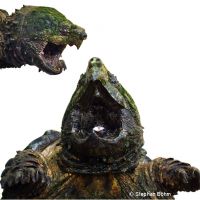Alligator Snapping Turtle (Macroclemys temminckii)
| Alligator Snapping Turtle Macroclemys temminckii | |
|---|---|
| Name | Alligator Snapping Turtle |
| Name Lat. | Macroclemys temminckii |
| Family | Snapping Turtles |
| Family lat. | Chelydridae |
| Order | Turtles |
| Order lat. | Testudines |
| Origin | USA |
| Habitat | Rivers, estuaries |
| Diet | Fish, small mammals |
| Humidity | 60-80 % |
| Behavior | Aggressive |
| Keeping | Individual |
| Care Level | Experts only |
| Reproduction | Oviparous |
| Housing | Aquaterrarium |
| Life Span | 50 years |
| Protection | CITES Appendix III; EU Annex C |
| Metric Units | |
| Size | 70 cm |
| Temperature | 25-30 °C |
| Housing Size | 250 x 100 x 100 cm |
| US Units | |
| Size | 28" |
| Temperature | 77-86 °F |
| Housing Size | 100" x 40" x 40" |
Distribution and habitat
The distribution area of the diurnal vulture turtles extends over large parts of the southeastern USA. There they live mainly in shallow, marshy and densely vegetated shore areas of rivers and their estuaries (brackish water).
Maintenance
Minimum dimensions for the aquaterrarium, according to the size and number of animals
| floor space for 1-2 animals: 3PL x 1,5PL (L x W) | Water level: 2PB |
The carapace length (PL) and carapace width (PB) is measured on the largest animal. For each additional animal, increase the footprint by 10%, and for the 5th animal and larger, increase the footprint by 20%. For adult animals an aquaterrarium of e.g. L 250 x W 100 x H 100 cm can be recommended, which should be placed in a quiet and vibration-free place
The incompatible and biting vulture turtles stay mainly in the water. The water part with a deep bottom of fine sand or gravel should be structured with roots and a stable stone structure (hiding place), which partially reaches the water surface. The water depth should be maximum twice the tank width, so that they can reach the water surface by lifting their head. They need only a small land part with a soft muddy sandy substrate. To maintain water quality, a powerful filter with low flow and frequent water changes are recommended.
| Water Temp | lighting | Sunny | |
| Summer | 24-28 °C | 12-14 hrs. | |
| winter (2-3 months) | 13-15 °C | 6-8 hrs |
Matt radiation sources are recommended, which they prefer penumbra and avoid glaring light.
Diet
The diet consists of live fish, fish fillets and meat of all kinds, including earthworms, supplemented with pelleted ready-made food. Young animals should be fed daily, adults twice a week. Regular addition of minerals and vitamins is important
A varied diet promotes health and prevents deficiency symptoms.
Reproduction and breeding
Males have a concave ventral carapace and a much longer tail than females. The anal opening of the male is closer to the tip of the tail than in the female.
A small, sandy land area is necessary for egg laying. There the eggs are buried about 20 cm deep. At a temperature of 25-29 °C the incubation period is 82-114 days.
The life expectancy can be over 50 years.
Species protection
According to § 3 of the Bundesartenschutzverordnung (BArtSchV) it is forbidden for private persons to offer these animals, to keep them in stock for sale, to keep them for sale or to sell them to others as well as to breed them!
Protection of species: WA appendix III; EU appendix C. Export permit required for animals from the USA.
Important
They like to burrow into the substrate for camouflage. When feeding on live fish, the "fishing" can be impressively observed, with two reddish, worm-shaped tongue processes in the wide-open mouth serving as bait for them. Be careful, bites can cause serious injuries!
Outdoor keeping is possible only during the summer months. The temperature should be at least 20 °C during the day and at least 15 °C at night
In order not to distort the native fauna, vulture turtles must not be released into the wild under any circumstances.
The terrarium must have good ventilation without drafts and meet the species-specific needs. Measuring devices such as thermometers, hygrometers, etc. are necessary. The lighting has to correspond to the species-specific day-night rhythm and has to be placed in such a way that the animals cannot injure themselves. The terrarium should be locked in such a way that neither unauthorized persons can open it nor the animals can escape. Contamination must be removed regularly
Further literature can be found in your pet store.
References
Text: Christian Sänger; Image: Stephan Böhm
Source: BMELV (1997): Mindestanforderungen an die Haltung von Reptilien; ENGELMANN (2006): Zootierhaltung - Tiere in menschlicher Obhut: Reptilien und Amphibien, Harri Deutsch Verlag
- Gemäß § 21 Abs. 5 Tierschutzgesetz idgF
